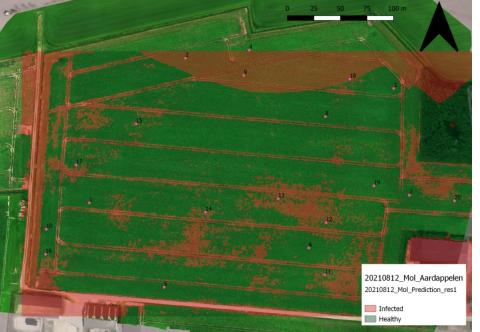Plant-parasitic nematodes cause significant economic losses in crop production, with root-knot nematodes (RKN; Meloidogyne spp.)) and potato cyst nematodes (PCN; Globodera spp.) being the top two in terms of agronomic impact. These are responsible for approximately 5% of global crop losses. Early detection is crucial as nematode damage can take years to become visible and lead to full field infestations if unmanaged. Accurate detection and monitoring methods are needed for effective management. The first visible symptoms of nematode damage are reduced plant growth, which can manifest as
patches or hotspots. If left unchecked, these patches can become full-field infestations, which can take years to develop as nematodes spread passively with soil and water movement. This underscores the importance of detecting nematodes in the early stages of infestation with high spatial accuracy for effective management.
Visual examination of plant roots for the presence of root galls or cysts is the most straightforward method of detecting nematode infestation. However, this approach is invasive and impractical for large-scale use. Additionally, infestation effects on plant canopies are non-specific and similar to signs of drought stress, making it impossible to identify infested plants based on visual canopy inspections. Remote sensing techniques such as hyperspectral and thermal imaging can address these problems. Early detection of nematodes necessitates high spatial and temporal resolution imaging spectroscopy and thermal data to assess subtle changes in spectral features and traits. The results of different experiments performed at three spatial levels (tubers, pot experiments, and field experiments) indicate that hyperspectral imaging allows accurate detection of infected plants and tubers, distinguishing between abiotic and biotic stress, detection of infection severity, and species identification.
Reference: Žibrat U., Viaene N., Širca S., van Beek J., Susič N., Gerič Stare B., 2023. NemDetect: Early detection of quarantine nematodes in potatoes using remote sensing. EFSA supporting publication 2023: 20(12):EN-8143. 45 pp. doi:10.2903/sp.efsa.2023.EN-8143








